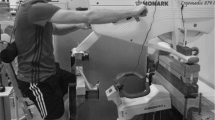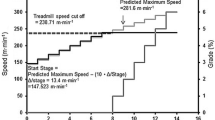Abstract
Based on the strong linear relationship between heart rate (HR) and oxygen consumption, the Åstrand–Ryhming cycle ergometer test (Astrand and Ryhming in J Appl Physiol 7:218–221, 1954) is a widely used submaximal test to predict whole body maximal oxygen consumption (\(\dot{V}{\text{O}}_{2\!\max }\)). However, a similar test predicting peak oxygen consumption (\(\dot{V}{\text{O}}_{{2{\text{peak}}}}\)) in the upper extremities is not established, and may be very useful for individuals unable to use their lower extremities or/and if separation of upper extremity aerobic capacity is sought after. Thus, the aim of the current study was to develop a submaximal test predicting \(\dot{V}{\text{O}}_{{2{\text{peak}}}}\) in arm-cycling. Forty-nine healthy volunteers (25 women: 38 ± 13 years; 24 men: 39 ± 12 years) tested arm-cycle \(\dot{V}{\text{O}}_{{2{\text{peak}}}}\) on a protocol with 4-min, 21-W increments to exhaustion. The data were contrasted to treadmill \(\dot{V}{\text{O}}_{2\!\max }\) values. Arm-cycle \(\dot{V}{\text{O}}_{{2{\text{peak}}}}\) was 66 ± 8% of \(\dot{V}{\text{O}}_{2\!\max }\) (r = 0.92, p < 0.001; women: 1.9 ± 0.4 L min−1; men: 3.0 ± 0.7 L min−1). Arm-cycle HR and \(\% \dot{V}{\text{O}}_{2}\) exhibited correlations of r = 0.79 and r = 0.78 for women and men, respectively, while corresponding correlations between work rate and \(\dot{V}{\text{O}}_{2}\) were r = 0.95 (women) and r = 0.89 (men) (all p < 0.001). Arm-cycle \(\dot{V}{\text{O}}_{{2{\text{peak}}}}\) prediction revealed a standard error of estimate (SEE) of 11.2% (women) and 10.2% (men), and was primarily due to individual arm-cycle maximal HR (women: 173 ± 13 beats min−1; men: 174 ± 10 beats min−1; correction factor: 5–7%). In conclusion, from a single 4-min stage of submaximal arm cycling, \(\dot{V}{\text{O}}_{{2{\text{peak}}}}\) can be predicted with a SEE of 10–11%. The arm-cycle test may have important value for individuals who rely on arms in sports and occupations, and for patients with lower extremity disabilities.




Similar content being viewed by others
References
Arabi H, Vandewalle H, Pitor P, de Lattre J, Monod H (1997) Relationship between maximal oxygen uptake on different ergometers, lean arm volume and strength in paraplegic subjects. Eur J Appl Physiol Occup Physiol 76:122–127. https://doi.org/10.1007/s004210050223
Astrand PO (1976) Quantification of exercise capability and evaluation of physical capacity in man. Prog Cardiovasc Dis 19:51–67
Astrand PO, Ryhming I (1954) A nomogram for calculation of aerobic capacity (physical fitness) from pulse rate during sub-maximal work. J Appl Physiol 7:218–221. https://doi.org/10.1152/jappl.1954.7.2.218
Åstrand PO, Rodahl K (1986) Textbook of work physiology. McGraw-Hill, New York
Bar-Or O, Zwiren LD (1975) Maximal oxygen consumption test during arm exercise—reliability and validity. J Appl Physiol 38:424–426. https://doi.org/10.1152/jappl.1975.38.3.424
Berg OK, Nyberg SK, Windedal TM, Wang E (2018) Maximal strength training-induced improvements in forearm work efficiency are associated with reduced blood flow. Am J Physiol Heart Circ Physiol 314:H853–H862. https://doi.org/10.1152/ajpheart.00435.2017
Borg GA (1982) Psychophysical bases of perceived exertion. Med Sci Sports Exerc 14:377–381
Brurok B, Helgerud J, Karlsen T, Leivseth G, Hoff J (2011) Effect of aerobic high-intensity hybrid training on stroke volume and peak oxygen consumption in men with spinal cord injury. Am J Phys Med Rehabil 90:407–414. https://doi.org/10.1097/PHM.0b013e31820f960f
Calbet JA, Holmberg HC, Rosdahl H, van Hall G, Jensen-Urstad M, Saltin B (2005) Why do arms extract less oxygen than legs during exercise? Am J Physiol Regul Integr Comp Physiol 289:R1448–1458. https://doi.org/10.1152/ajpregu.00824.2004
Calbet JA, Gonzalez-Alonso J, Helge JW, Sondergaard H, Munch-Andersen T, Saltin B, Boushel R (2015) Central and peripheral hemodynamics in exercising humans: leg vs arm exercise. Scand J Med Sci Sports 25(Suppl 4):144–157. https://doi.org/10.1111/sms.12604
Eerden S, Dekker R, Hettinga FJ (2018) Maximal and submaximal aerobic tests for wheelchair-dependent persons with spinal cord injury: a systematic review to summarize and identify useful applications for clinical rehabilitation. Disabil Rehabil 40:497–521. https://doi.org/10.1080/09638288.2017.1287623
Franklin BA (1985) Exercise testing, training and arm ergometry. Sports Med 2:100–119. https://doi.org/10.2165/00007256-198502020-00003
Franklin BA, Vander L, Wrisley D, Rubenfire M (1983) Aerobic requirements of arm ergometry: implications for exercise testing and training. Phys Sports Med 11:81–90. https://doi.org/10.1080/00913847.1983.11708659
Grant JA, Joseph AN, Campagna PD (1999) The prediction of VO2max: a comparison of 7 indirect tests of aerobic power. J Strength Cond Res 13:346–352
Helgerud J (1994) Maximal oxygen uptake, anaerobic threshold and running economy in women and men with similar performances level in marathons. Eur J Appl Physiol Occup Physiol 68:155–161
Helgerud J et al (2007) Aerobic high-intensity intervals improve VO2max more than moderate training. Med Sci Sports Exerc 39:665–671. https://doi.org/10.1249/mss.0b013e3180304570
Hoff J, Kemi OJ, Helgerud J (2005) Strength and endurance differences between elite and junior elite ice hockey players The importance of allometric scaling. Int J Sports Med 26:537–541. https://doi.org/10.1055/s-2004-821328
Kanda K, Hashizume K, Miwa T, Miwa Y (1996) Overloading a muscle does not alter the rate of motoneuronal loss in aged rats. Neurobiol Aging 17:613–617
Kodama S et al (2009) Cardiorespiratory fitness as a quantitative predictor of all-cause mortality and cardiovascular events in healthy men and women: a meta-analysis. JAMA 301:2024–2035. https://doi.org/10.1001/jama.2009.681
Larsson PU, Wadell KM, Jakobsson EJ, Burlin LU, Henriksson-Larsen KB (2004) Validation of the MetaMax II portable metabolic measurement system. Int J Sports Med 25:115–123. https://doi.org/10.1055/s-2004-819953
Legge BJ, Banister EW (1986) The Astrand–Ryhming nomogram revisited. J Appl Physiol 61:1203–1209. https://doi.org/10.1152/jappl.1986.61.3.1203
Laskin JJ, Slivka D, Frogley M (2004) A cadance based sub-maximal field test for the prediction of peak oxygen consumption in elite wheelchair basketball athletes. J Exerc Physiol Online 7:8–18
Myers J, Prakash M, Froelicher V, Do D, Partington S, Atwood JE (2002) Exercise capacity and mortality among men referred for exercise testing. N Engl J Med 346:793–801. https://doi.org/10.1056/NEJMoa011858
Noonan V, Dean E (2000) Submaximal exercise testing: clinical application and interpretation. Phys Ther 80:782–807
Nyberg SK, Berg OK, Helgerud J, Wang E (2017) Blood flow regulation and oxygen uptake during high-intensity forearm exercise. J Appl Physiol 122:907–917. https://doi.org/10.1152/japplphysiol.00983.2016
Price MJ, Campbell IG (1997) Determination of peak oxygen uptake during upper body exercise. Ergonomics 40:491–499. https://doi.org/10.1080/001401397188116
Saltin B (1990) Maximal oxygen uptake: limitations and malleability. In: Terjung K, Nazar RL (eds) International perspectives in exercise physiology. Human Kinetics Publishers, Champaign, pp 26–40
Sawka MN (1986) Physiology of upper body exercise. Exerc Sport Sci Rev 14:175–211
Sawka MN, Foley ME, Pimental NA, Pandolf KB (1983a) Physiological factors affecting upper body aerobic exercise. Ergonomics 26:639–646. https://doi.org/10.1080/00140138308963385
Sawka MN, Foley ME, Pimental NA, Toner MM, Pandolf KB (1983b) Determination of maximal aerobic power during upper-body exercise. J Appl Physiol Respir Environ Exerc Physiol 54:113–117. https://doi.org/10.1152/jappl.1983.54.1.113
Sedlock DA (1991) Postexercise energy expenditure following upper body exercise. Res Q Exerc Sport 62:213–216. https://doi.org/10.1080/02701367.1991.10608712
Smith PM, Price MJ, Doherty M (2001) The influence of crank rate on peak oxygen consumption during arm crank ergometry. J Sports Sci 19:955–960. https://doi.org/10.1080/026404101317108453
Storen O et al (2017) The effect of age on the VO2max response to high-intensity interval training. Med Sci Sports Exerc 49:78–85. https://doi.org/10.1249/MSS.0000000000001070
Wang E, Hoff J, Loe H, Kaehler N, Helgerud J (2008) Plantar flexion: an effective training for peripheral arterial disease. Eur J Appl Physiol 104:749–756. https://doi.org/10.1007/s00421-008-0826-3
Wang E, Solli GS, Nyberg SK, Hoff J, Helgerud J (2012) Stroke volume does not plateau in female endurance athletes. Int J Sports Med 33:734–739. https://doi.org/10.1055/s-0031-1301315
Weissland T, Marais G, Robin H, Vanvelcenaher J, Pelayo P (1999) Relationship in humans between spontaneously chosen crank rate and power output during upper body exercise at different levels of intensity. Eur J Appl Physiol Occup Physiol 79:230–236. https://doi.org/10.1007/s004210050500
Wisloff U, Helgerud J (1998) Methods for evaluating peak oxygen uptake and anaerobic threshold in upper body of cross-country skiers. Med Sci Sports Exerc 30:963–970
Author information
Authors and Affiliations
Contributions
JH and JH conceived and designed research; BEØ and EW conducted experiments; BEØ and EW analyzed data; BEØ, EW and JH, wrote the manuscript. All authors read and approved the manuscript.
Corresponding author
Ethics declarations
Conflict of interest
The authors declare no conflicts of interest.
Additional information
Communicated by Philip D. Chilibeck.
Publisher's Note
Springer Nature remains neutral with regard to jurisdictional claims in published maps and institutional affiliations.
Rights and permissions
About this article
Cite this article
Helgerud, J., Øiestad, B.E., Wang, E. et al. Prediction of upper extremity peak oxygen consumption from heart rate during submaximal arm cycling in young and middle-aged adults. Eur J Appl Physiol 119, 2589–2598 (2019). https://doi.org/10.1007/s00421-019-04225-3
Received:
Accepted:
Published:
Issue Date:
DOI: https://doi.org/10.1007/s00421-019-04225-3




